Недавно мне понадобилось создать гаджет для Windows Sidebar. Навыков в этом у меня не было, поэтому, немного погуглив и почитав документацию, приступаем.
Сразу покажу то, что получилось в итоге
Гаджет будет получать информацию с сайта в виде xml, парсить и, собственно, отображать. Также гаджет будет проверять наличие новых версий, и в случае их присутствия, отказываться работать 
Изначально, ради получения опыта, хотел написать гаджет полностью на VBScript (так как с ним еще не имел дела), но в конечном итоге пришлось делать вставки на JavaScript.
Перейдем непосредственно к коду. Весь код здесь я рассматривать не буду, покажу лишь основные моменты. Ссылка на готовый гаджет – в конце статьи.
Главный файл гаджета – его манифест – файл Gadget.xml. Он должен называться именно так и располагаться в корне нашего архива (гаджет есть ни что иное, как архив ZIP с расширением .gadget).
<?xml version="1.0" encoding="utf-8" ?>
<gadget>
<name>Weather from Info.Denms.Ru</name>
<version>1.0.1232</version>
<hosts>
<host name="wdenms">
<base type="HTML" apiVersion="1.0.0" src="main.html" />
<permissions>Full</permissions>
<platform minPlatformVersion="1.0" />
</host>
</hosts>
<icons>
<icon width="64" height="64" src="icon.png" />
</icons>
<author name="cvs">
<info url="http://info.denms.ru" />
</author>
<description>Weather Widget (Info.Denms.Ru)</description>
</gadget>
Рассмотрим его более подробно.
Элемент <base> должен содержать apiVersion, равный 1.0.0 (на данный момент), а также атрибут src, в котором указан главный файл нашего гаджета;
<permissions> — разрешения для гаджета. Устанавливаем равным full;
<platform> — минимальная версия Widows Sidebar. На данный момент – 1.0;
Параметры <name> — имя гаджета, <version> — версия, <author> — информация об авторе, <info> — ссылка на страницу с гаджетом, <icon> — иконка гаджета и <descrtiption> будут отображаться на панели установленных гаджетов.
Файл main.html – обычный html файл, приводить его полностью не буду, остановлюсь лишь на некоторых моментах.
С помощью элемента g:background задается фон гаджета. Сделаем его прозрачным.
<g:background id="background" style="position:absolute; z-index:-1; top:0; left:0;" opacity="0"></g:background>Гаджет может находиться в двух состояниях – docked (слева на скрине выше), и undocked (справа). Будем хранить текущее состояние гаджета в переменной JavaScript docked.
<SCRIPT Language="VBScript">
'Вызов функции JavaScript из области VBS
function isDocked
isDocked = isDockedJS()
End Function
</script>
<script src="main.vbs" type="text/vbscript"></script>
<SCRIPT Language="JavaScript">
docked = 0;
function isDockedJS() {
return docked;
}
</SCRIPT>
<script type="text/javascript" src="main.js"></script>Функция-обертка isDocked потребуется нам в дальнейшем, чтобы из VBScript узнать текущее состояние гаджета (как я не старался, но реализовать это на чистом VBScript не смог). Еще одно замечание – скрипты корректно работают именно в этом порядке, т.е. сначала описываем скрипты VBScript, потом JavaScript.
Остальные элементы в main.html представлены элементами DIV с абсолютным позицированием. Впоследствии из скриптов мы будем обращаться к ним по их id.
<div id="small_needupdate"></div>С помощью JavaScript зададим состояния docked и undocked для гаджета, а так же укажем файл настроек (main.js)
System.Gadget.onDock = resize;
System.Gadget.onUndock = resize;
System.Gadget.settingsUI = "settings.html";
System.Gadget.onSettingsClosed = SettingsClosed;
docked=0; //начальное состояние гаджета
resize(); //инициализацияКак видно из листинга выше, при смене состояний гаджета будет вызываться функция resize().
function resize() {
bd = document.body.style;
System.Gadget.beginTransition();
if (System.Gadget.docked) {
// small state
bd.width=148; //устанавливаем размеры гаджета
bd.height=201;
docked = 1;
bd.background='url(images/gadget.png) no-repeat'; //устанавливаем фон
//далее следует перенос значений из состояния undocked в docked и обнуление элементов для состояния undocked
document.getElementById("small_needupdate").innerHTML = document.getElementById("big_needupdate").innerHTML;
document.getElementById("big_needupdate").innerHTML = "";
//...
} else {
// big state
bd.width=230;
bd.height=160;
bd.background='url(images/gadgeth.png) no-repeat';
docked=0;
//перенос значений из состояния docked в undocked и обнуление элементов для состояния docked
document.getElementById("big_needupdate").innerHTML = document.getElementById("small_needupdate").innerHTML;
document.getElementById("small_needupdate").innerHTML = "";
//...
}
System.Gadget.endTransition(System.Gadget.TransitionType.morph,1);
}Также можно описать функцию сохранения настроек. В моем гаджете их нет, но для примера покажу как это делается
function SettingsClosed(event) {
if (event.closeAction == event.Action.commit) {
//alert System.Gadget.Settings.readString('test');
}
}readString – читает ранее сохраненную строку, writeString, соответственно, записывает.
Методы System.Gadget.beginTransition(); и System.Gadget.endTransition(); нужны для “плавного» изменения размера гаджета. В Windows Seven они игнорируются, но я все же оставил их для обратной совместимости.
Как уже говорилось выше, сервер предоставляет нам информацию о погоде в формате xml.
<?xml version="1.0"?>
<all>
<day id="today">
<temp>1.7</temp>
<cloudyim>41</cloudyim>
<cloudy>пасмурно</cloudy>
<air>снег</air>
<humidity>87</humidity>
<wind_direction>Ю-З</wind_direction>
<wind_speed>5</wind_speed>
<min>-3</min>
<max>-1</max>
</day>
<day id="ПТ">
<min>-1</min>
<cloudyim>26</cloudyim>
<max>1</max>
</day>
<day id="СБ">
<min>-9</min>
<cloudyim>41</cloudyim>
<max>0</max>
</day>
…
</all>Скачивать и парсить xml будем на VBScript.
Sub DownloadXML2
Set objXML = CreateObject("Microsoft.XmlHttp")
objXML.Open "GET", "http://info.kovonet.ru/weather.xml", True
objXML.OnReadyStateChange = GetRef("objXML_onreadystatechange")
objXML.setRequestHeader "If-Modified-Since", "Sat, 1 Jan 2000 00:00:00 GMT"
objXML.Send
iTimeoutID = window.SetTimeout("mySleep", 1000)
End SubФункция mySleep будет проверять наше соединение на таймаут.
Sub mySleep
if bRespReceived = "false" then 'ответ еще не получен
iTimeout = iTimeout + 1
if (iTimeout > 30) then 'таймаут
timerFirstRun = window.SetTimeout("Update", 60000) 'попытка повторного обновления через минуту
else 'таймаут еще не достигнут, продолжаем считать секунды
iTimeoutID = window.SetTimeout("mySleep", 1000)
end if
end if
End SubВ случае успешного скачивания objXML.readyState будет равен четырем, а статус (objXML.status) вернет значение 200.
Function objXML_onreadystatechange()
If (objXML.readyState = 4) Then
'msgbox objXML.statusText
If (objXML.status = 200) Then
bRespReceived=true
SaveFile(objXML.responseText)
else
timerFirstRun = window.SetTimeout("Update", 60000) 'попытка повторного обновления через минуту
End If
End If
End Function
В этом случае сохраняем файл во временную папку Windows
Function SaveFile(what)
Set fso = CreateObject("Scripting.FileSystemObject")
tempFolder = fso.GetSpecialFolder(2)
filepath = tempFolder+"\weather.xml"
Dim fso1, tf
Set fso1 = CreateObject("Scripting.FileSystemObject")
Set tf = fso1.CreateTextFile(filepath, True, True) 'rewrite, unicode
tf.Write(what)
tf.Close
ParseXML
End Functionи начинаем парсить файл.
Sub ParseXML
Set fso = CreateObject("Scripting.FileSystemObject")
tempFolder = fso.GetSpecialFolder(2)
filepath = tempFolder+"\weather.xml"
Set xmlDoc = CreateObject("Msxml2.DOMDocument")
xmlDoc.async="false"
xmlDoc.load(filepath)
'главная нода – в нашем случае <all>
Set currNode = xmlDoc.documentElement
'дни недели – <day>
Set dayNode = currNode.firstChild
While Not dayNode Is Nothing
Set currNode = dayNode.firstChild
While Not currNode Is Nothing
if currNode.parentNode.getAttribute("id") = "today" then 'сегодняшний день
if currNode.nodeName = "temp" then document.getElementById(prefix+"maintemp").innerHTML = currNode.childNodes(0).text+Chr(176)
'отображаем остальные элементы
Else 'не сегодняшний день, отображаем более мелко
'...
end If
Set currNode = currNode.nextSibling
Wend
Set dayNode = dayNode.nextSibling
Wend
End SubПроверка на новые версии производится точно таким же способом.
Не забываем создать файл настроек — settings.html, о существовании которого мы объявили выше.
<html>
<head>
<title>Настройки</title>
<style type="text/css">
body { width:220px; height:120px; }
</style>
</head>
<body>
<div style="text-align:center">
<strong>Weather from Info.Denms.Ru<br/><script type="text/javascript">document.write(System.Gadget.version);</script></strong><br/>
© cvs, 2011<br/>
<a href="http://info.denms.ru">http://info.kovonet.ru</a><br/><br/>
</div>
</body>
</html>
Вот, собственно, и все. Буду рад, если моя (первая :)) статья оказалась кому-то полезной.
Использованные источники:
http://www.script-coding.com/XMLDOMscripts.html;
http://msdn.microsoft.com/en-us/library/bb508511%28v=VS.85%29.aspx;
VBScript Programmers Reference, 3rd Edition;
ну, и, конечно, http://google.com.
Ссылка на гаджет – http://info.kovonet.ru/test.gadget.
In this article, I will show you how to create custom Widgets in Windows 11. For the purpose of this guide, we will use an application named BeWidgets, available on the Microsoft Store.
We all know the new Widgets section in Windows 11, but few of us actually use it. The main reason for that is because that section is really limited and has very few options regarding creating custom or personalized widgets. The program we will install today will help us create custom Widgets in Windows 11.
Download BeWidgets from the Microsoft Store
The interface of the app is really simple, but don’t worry, you’ll have a lot of settings to choose from when creating your custom widget.
By clicking on the New Widget button, you will be able to create a fully customizable widget, starting from a certain preset, or even from nothing.
In the Layouts section, you will be able to save multiple layouts of widgets to which you will be able to come back later on.
In the Settings section, you have some general settings of the app and also some appearance settings that you can choose from, including Dark Mode which I will be using throughout this article.

When creating a new widget, you can select a certain preset, and then on the Customize button, you have unlimited options of personalizing the created widget.
You can fully customize the position, size, appearance, and style of the widget. The only limitation is your own imagination.

And of course, you can move the widget freely wherever you want, on your screen.
By enabling the Always on top option, you can even have your widgets always on top, regardless of the windows that you currently have opened on your computer.

For a more in-depth explanation, and tutorial you can watch the video below from the youtube channel.
Windows 11 introduces a more refined user interface, focusing on productivity, aesthetics, and intuitive interactions. One prominent feature is its widget functionality, designed to deliver personalized, glanceable information directly to users, without navigating away from their current tasks. This article will guide you through the process of creating widgets on Windows 11, exploring the necessary tools, code snippets, and best practices to ensure your widgets are not only functional but also visually appealing.
Understanding Widgets in Windows 11
Widgets in Windows 11 serve as mini-applications that provide information at a glance. They can display news updates, weather forecasts, calendar events, to-do lists, and much more. The design emphasis is primarily on simplicity and personalization, enabling users to customize their desktop experience according to their needs and preferences.
Core Technologies
Before you begin creating your widget, it’s crucial to understand the technology stack involved:
-
Web Technology: Windows widgets are built using standard web technologies such as HTML, CSS, and JavaScript. This makes it accessible for many developers familiar with web development.
-
Windows API: To interact with system features and ensure your widget conforms to Windows design guidelines, you may need to integrate with the Windows API and the Windows Runtime.
-
Microsoft’s Adaptive Cards: For enriched user interactions and data presentation, Microsoft recommends using Adaptive Cards, a framework for creating interactive experiences across different platforms.
Setting Up Your Development Environment
To start creating widgets on Windows 11, you need to set up your development environment properly.
1. Install Visual Studio
First, download and install Visual Studio from the official website. Choose the Community Edition, which is free for individual developers and small teams. During installation, ensure you include the «Universal Windows Platform development» and «Web Development» workloads.
2. Enable Developer Mode
To run and test your widget, you need to enable Developer Mode on your Windows 11 system:
- Go to Settings > Privacy & Security > For Developers.
- Toggle the Developer Mode switch to On.
This setting allows you to sideload apps and execute them directly from Visual Studio.
Creating Your First Widget
Let’s walk through the creation of a simple weather widget as an example:
Step 1: Create a New Project
- Open Visual Studio.
- Click on Create a new project.
- Choose Blank App (Universal Windows) as your project template.
- Name your project (e.g.,
WeatherWidget) and select the location where you want to save it.
Step 2: Define the UI Structure
-
Navigate to the
MainPage.xamlfile. This is where you will define your widget’s user interface using XAML.Here’s a simple XAML layout for your weather widget:
Step 3: Add Functionality with JavaScript
Now you need to add some JavaScript to fetch weather data from a public API. For this, you can use the OpenWeatherMap API:
- Sign up at OpenWeatherMap to get your API key.
- In your project, create a new file (e.g.,
weather.js) to handle API calls.
const WEATHER_API_KEY = 'your_api_key_here';
const WEATHER_API_URL = 'https://api.openweathermap.org/data/2.5/weather?q=London&appid=' + WEATHER_API_KEY;
fetch(WEATHER_API_URL)
.then(response => response.json())
.then(data => {
document.getElementById('WeatherInfo').innerText = `Temperature: ${(data.main.temp - 273.15).toFixed(2)} °C`;
})
.catch(error => console.error('Error fetching weather data:', error));- Ensure this JavaScript file is referenced in your
MainPage.xaml:
- Call the JavaScript function in your
OnNavigatedToevent:
protected override void OnNavigatedTo(NavigationEventArgs e)
{
LoadWeatherData();
}Adding Style and Enhancements
With the basic functionality in place, it’s time to enhance the visual presentation using CSS. Create a stylesheet (e.g., styles.css):
body {
background-color: #f0f0f5;
text-align: center;
}
#WeatherInfo {
color: #0078d7;
font-size: 22px;
margin-top: 10px;
}Reference this CSS in your index.html file:
Testing Your Widget
- In Visual Studio, click on the Start Debugging button (or press
F5). This will build your project and run it on your local machine. - Once the project is running, you can test your widget in the Windows 11 environment. If everything is set up correctly, it should fetch and display the weather data as defined.
Packaging Your Widget for Deployment
After you’re content with your widget’s functionality and appearance, you’ll want to package it for distribution:
- Right-click on your project in the Solution Explorer.
- Go to Store > Create App Packages.
- Follow the wizard steps to create a package. You’ll get an
.appxor.msixfile, which can be used for installation on other Windows 11 systems.
Publishing Your Widget
To distribute your widget widely, you can publish it to the Microsoft Store. Here are the steps:
- Create a developer account on the Microsoft Partner Center.
- Submit your widget package through the dashboard, along with the necessary metadata (descriptions, icons, screenshots).
- After review, your widget may be published, making it available for all Windows 11 users to download.
Best Practices for Designing Widgets
Creating a successful widget goes beyond simple functionality. Here are some best practices to keep in mind while developing your widgets for Windows 11:
1. Simplify the User Interface
Widgets are meant for quick access to information. Avoid clutter and ensure the layout is clean. Use white space effectively to separate different elements.
2. Ensure Responsiveness
Your widget must adapt to different screen sizes and orientations. Use flexible layouts with relative sizes, ensuring a consistent appearance across devices.
3. Use Adaptive Cards
For widgets that require user input or deeper interaction, utilize Microsoft’s Adaptive Cards framework. This will allow you to build interactive UI components that look consistent across applications.
4. Optimize Performance
Widgets should load quickly and not consume excessive resources. Optimize your JavaScript, CSS, and images for better performance. Performance metrics should be monitored during development.
5. Focus on Accessibility
Accessibility is paramount. Ensure that text is readable (sufficient contrast, font size) and that keyboard navigation is possible. Use semantic HTML whenever applicable.
6. Personalization
Allow users to customize your widgets. Provide settings for users to change themes, toggle information, and choose the data they wish to see. This leads to greater user engagement and satisfaction.
7. Regular Updates
If your widget relies on changing data (like news or weather), ensure it refreshes regularly and displays current information. Provide options for users to set update intervals.
Conclusion
Creating widgets in Windows 11 is an exciting opportunity for developers to enhance user productivity and provide personalized experiences. By leveraging the robust web development stack, including HTML, CSS, and JavaScript, developers can create functional and visually pleasing widgets.
Through adequate testing, optimization, and adherence to best practices, these widgets can not only serve their purpose but also engage users more effectively. With the potential for distribution through the Microsoft Store, the opportunities for creativity and utility in widget design are boundless. Whether you’re building utility tools, entertainment widgets, or information panels, your possibilities are only limited by your imagination. With this guide, you are well on your way to becoming a proficient widget creator on Windows 11.
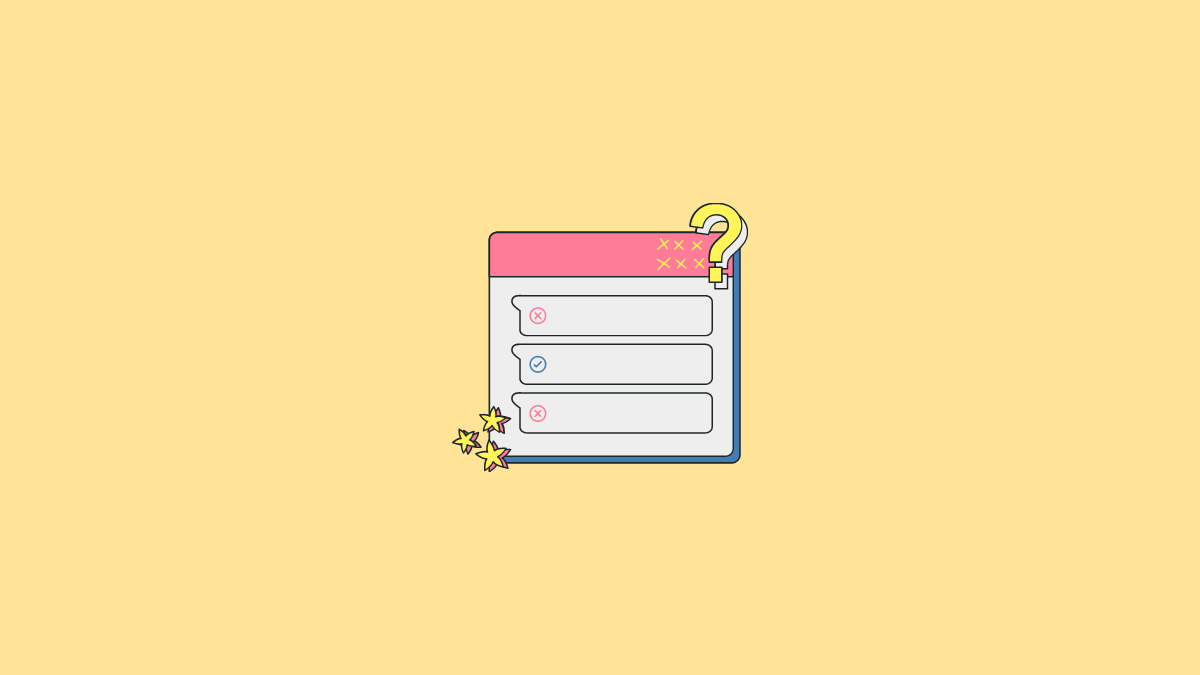
Windows 11 is here and one of the first things that an avid Windows user would appreciate is the look and overall design of the Windows shell experience. Everything is centralized and beckons the user even with its minimalist design.
Designers and app creators are using the base design of Windows 11 to explore further customization possibilities, and one of the recent apps to come out is ‘Live Tiles Anywhere’ app. Let’s see what it has to offer and how you can create live tiles (like those on Windows 10) and widgets using ‘Live Tiles Anywhere’ on Windows 11.
What is ‘Live Tiles Anywhere’ app?
Most of us remember ‘Live Tiles’ as that Windows 10 Start Menu feature that never really took off. It’s understandable then that Microsoft didn’t implement it in Windows 11. But the idea behind Live Tiles was not all out of whack.
Live Tiles were square-shaped tiles that contained a picture or a number and showed notifications previews from apps. They also rotated sometimes and had links to starts programs. But their application (no pun intended) was never quite done right and they tended to stay within the Start Menu only.
However, one developer has created a modified version of it – Live Tiles Anywhere – which, as the name suggests, can be used anywhere you like, be it in the Start Menu or as desktop widgets. Let’s see ‘Live Tiles Anywhere’ in action and see how you can create them on Windows 11.
How to install Live Tiles Anywhere on Windows 11
Live Tiles Anywhere is available as an app from the Microsoft Store.
Download: Live Tiles Anywhere on Microsoft Store
Click on the link above to get Live Tiles Anywhere from your browser. Alternatively, press Start, type ‘store’, and open the Microsoft Store.
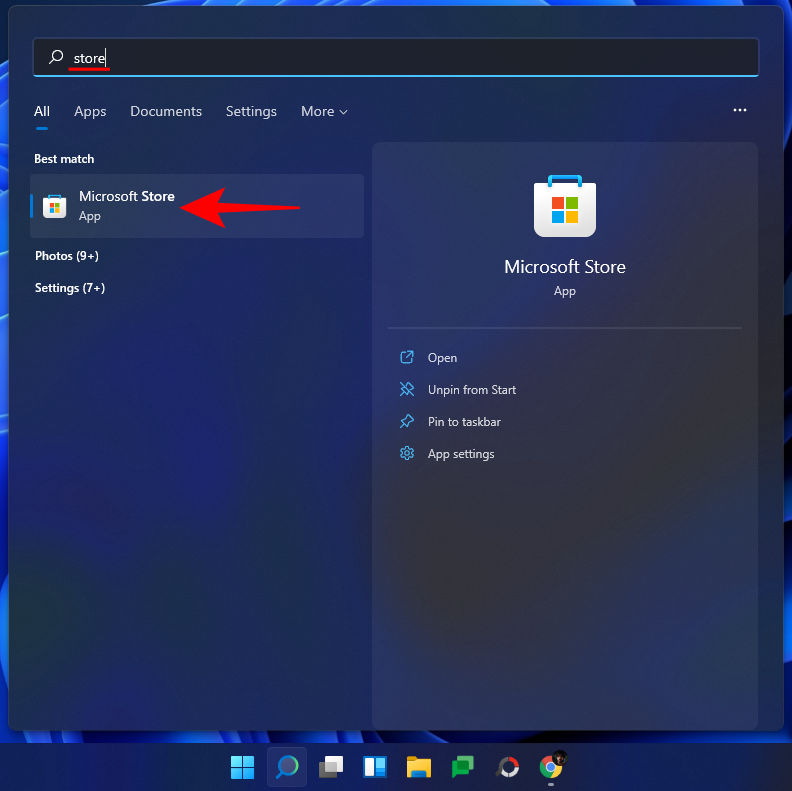
Here, search for Live Tiles Anywhere and select it from the list of available options.
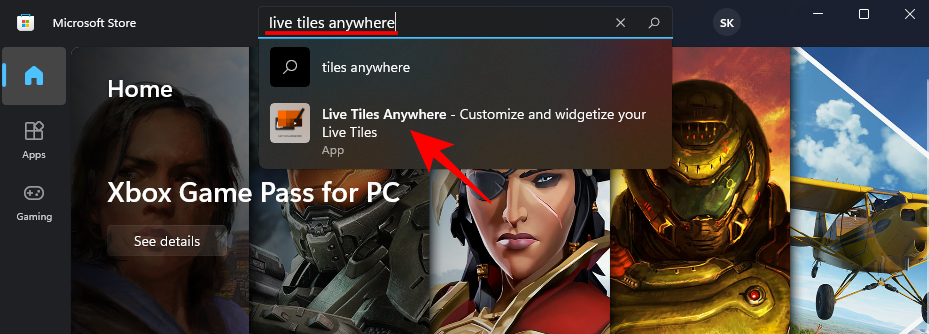
Then click on Get.

Once it’s downloaded and installed, click on Open.
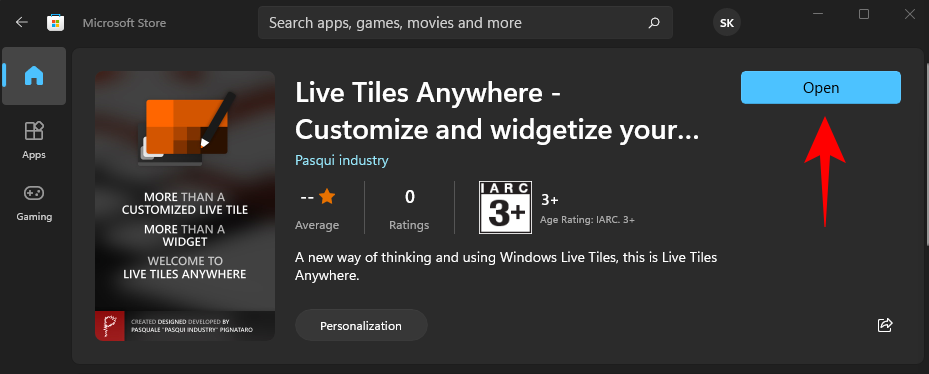
Once Live Tiles Anywhere opens up, you will be under the ‘Custom Tiles’ tab by default. Here, click on Create a new custom tile.
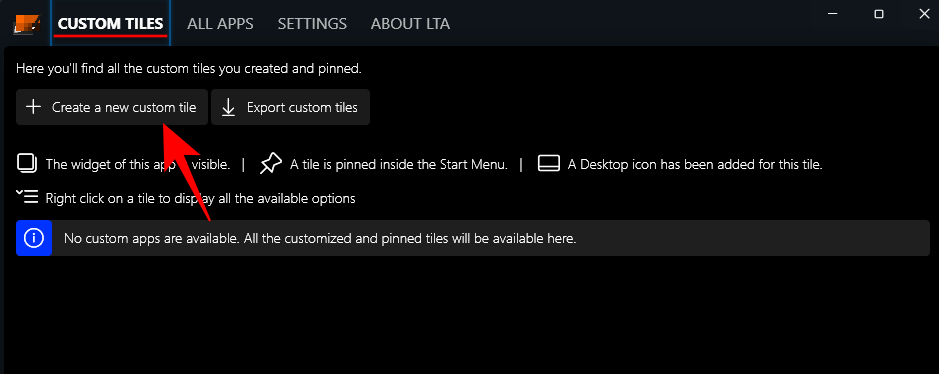
This will bring you to the Tile Editor window. Firstly, click on Element to execute in the left panel.
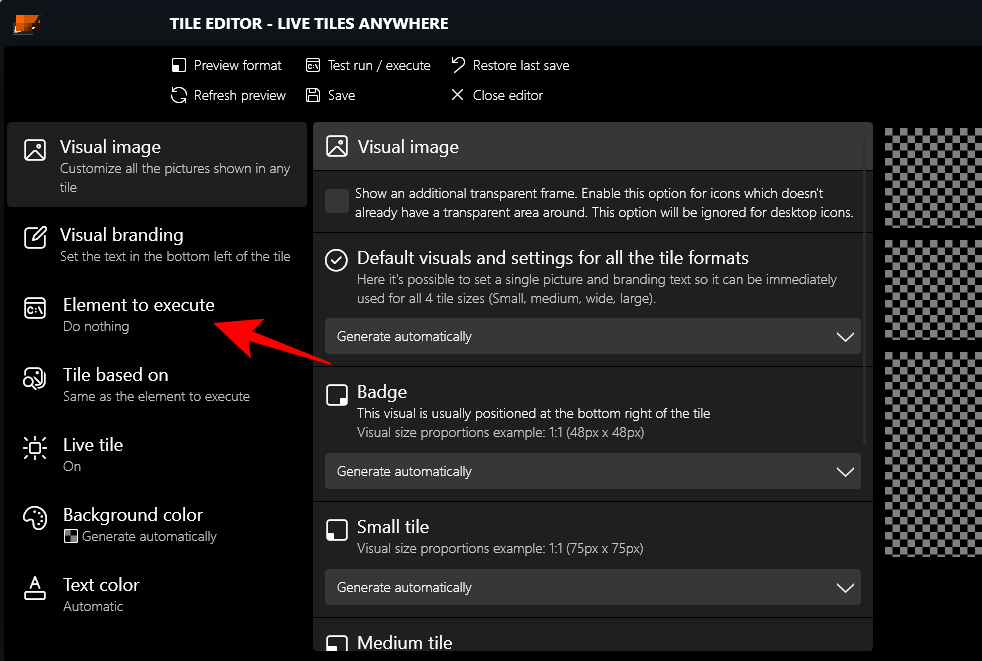
Here, click on the drop-down menu.
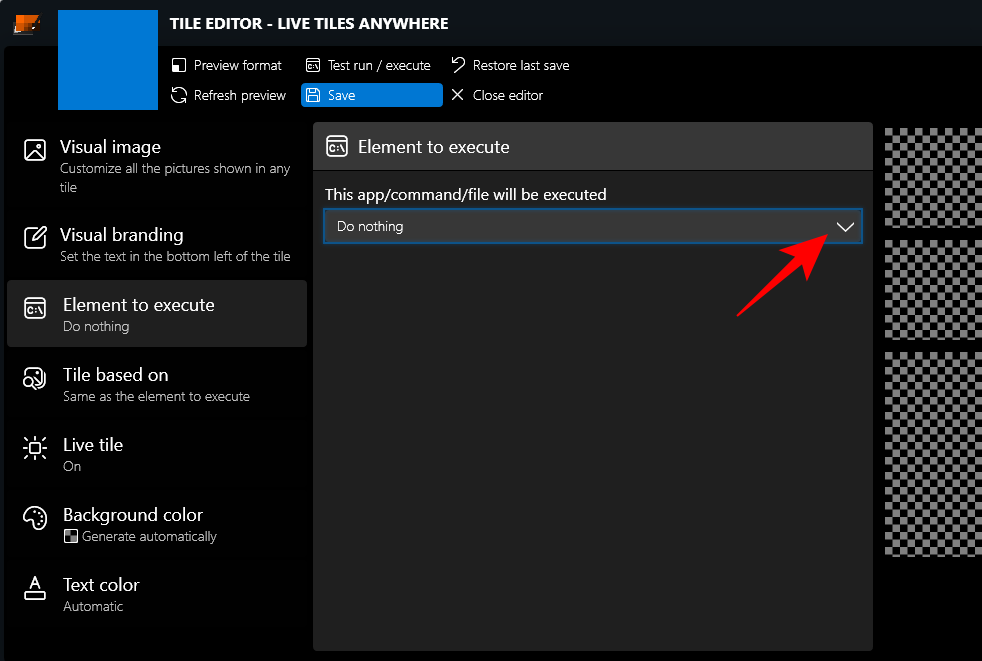
Then select Installed apps.

Then click on Pick an app.
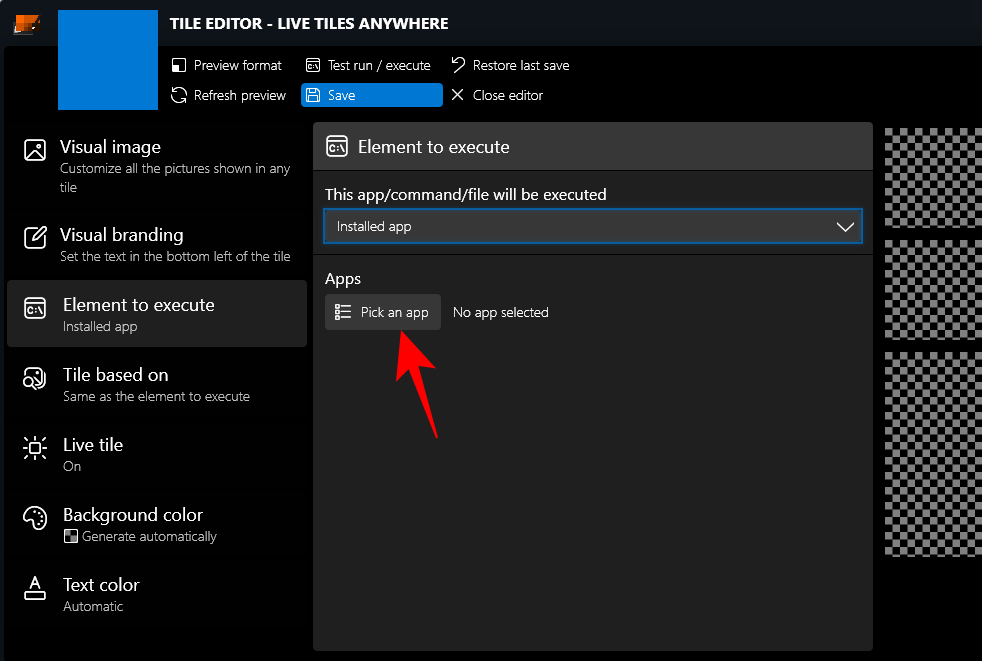
Select an app for your first Live Tile and click on Save.
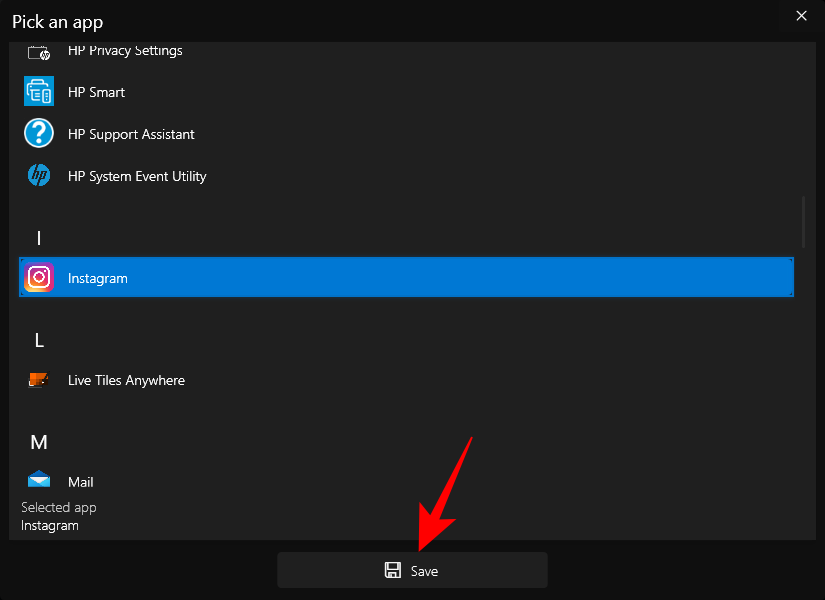
There are a few other customization options such as Background color, text color, visual image, and visual branding, etc. that you can look through.
Click on Save to finish.
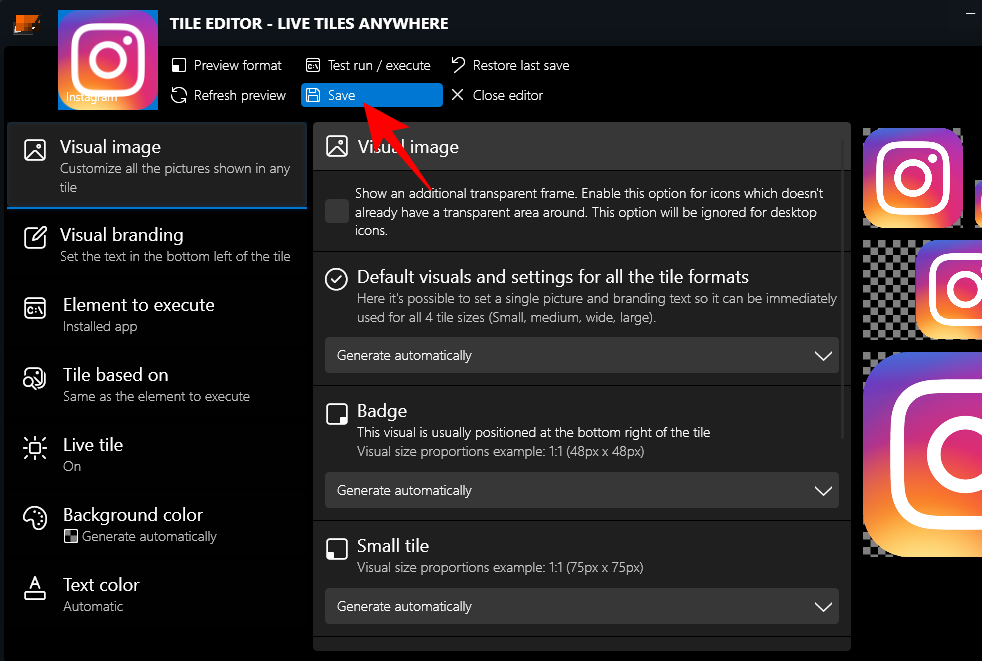
Then click Save and close.
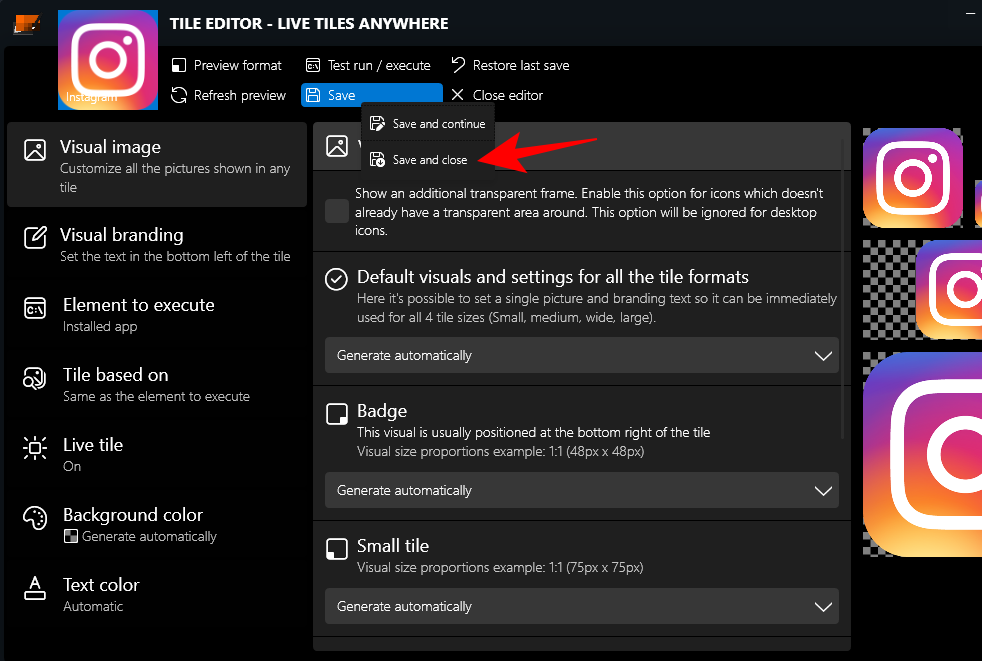
Under the ‘Custom Tiles’ tab, right-click on the tile and click on Pin to the Start Menu.
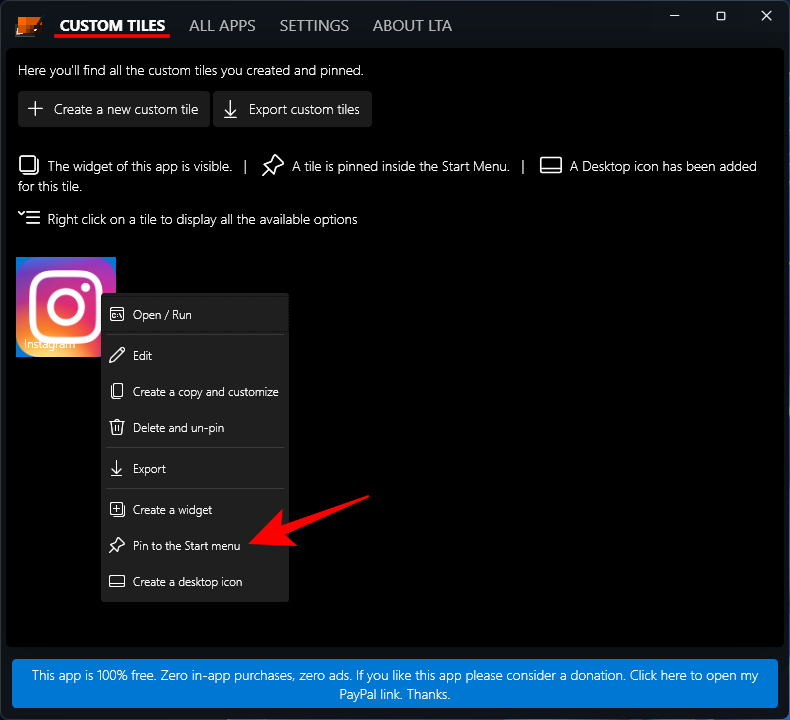
When prompted, click Yes.
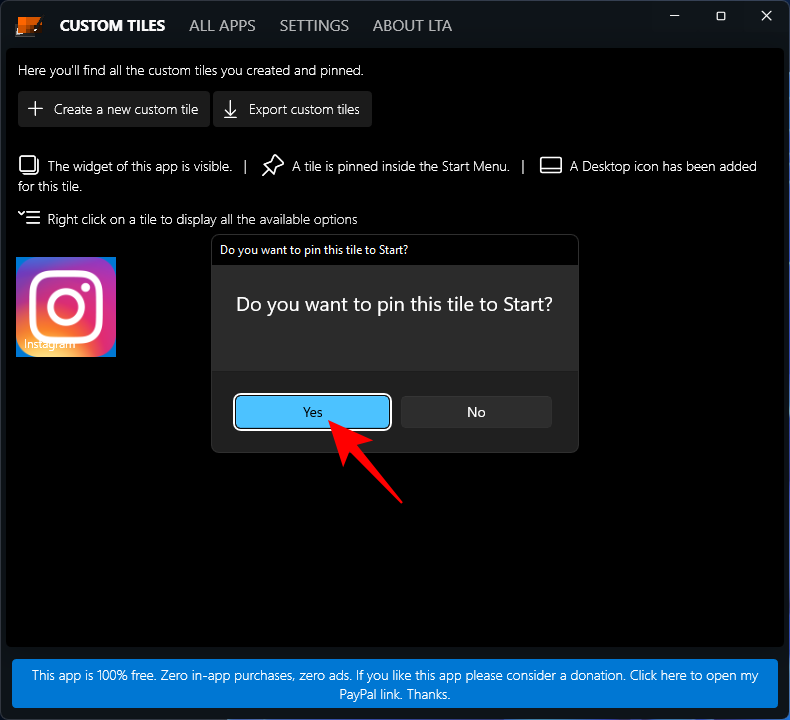
Currently, the app isn’t optimized to show live tiles in the Windows 11 Start Menu nor is it meant to replace its UI components, which use small ‘badges’ as app icons. If you’re using Windows 10, however, you will see it as an actual live tile.
You can also put this tile on the desktop. To do so, right-click the tile and select Create a desktop icon.
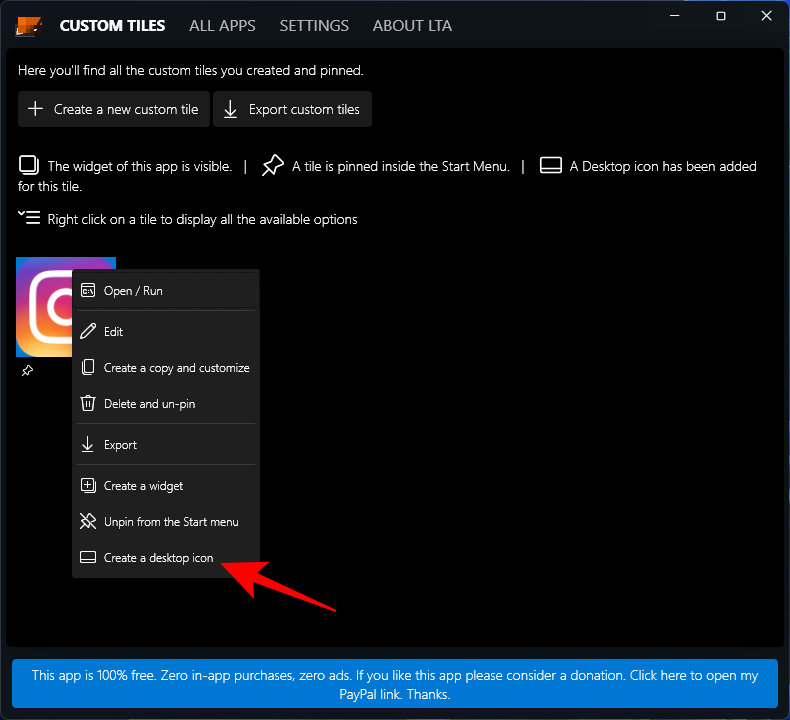
Use Live Tiles as Widgets on Windows 11
Once a custom live tile is created, it can be used as a widget to be placed anywhere on the desktop. To do so, right-click on the live tile and select Create a widget.
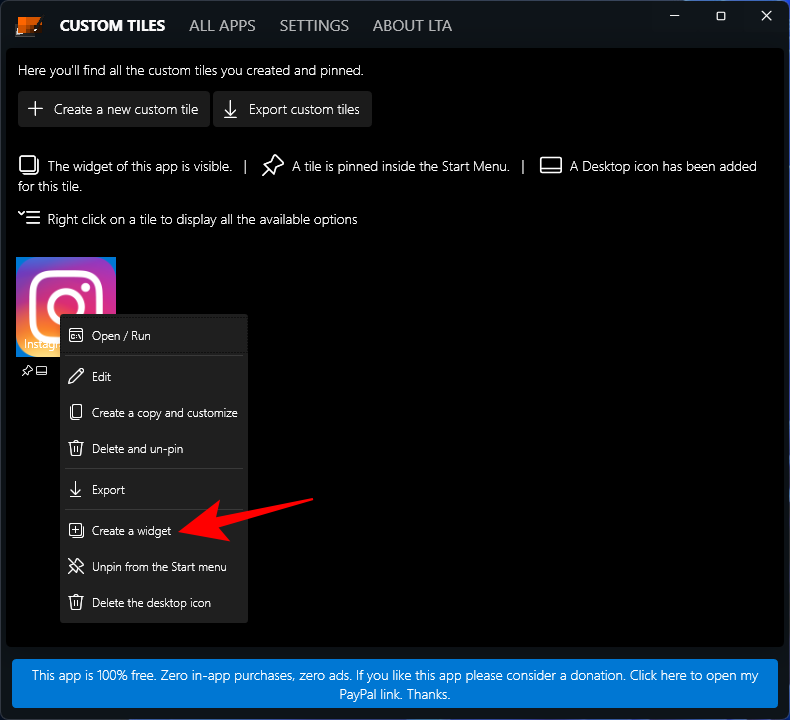
Another, quicker way to create a widget on the desktop is to do so without creating a custom live tile. For this, open the ‘Live Tiles Anywhere’ app and go to the ‘All Apps’ tab. Here, search for an app, right-click on it and select Create a widget.
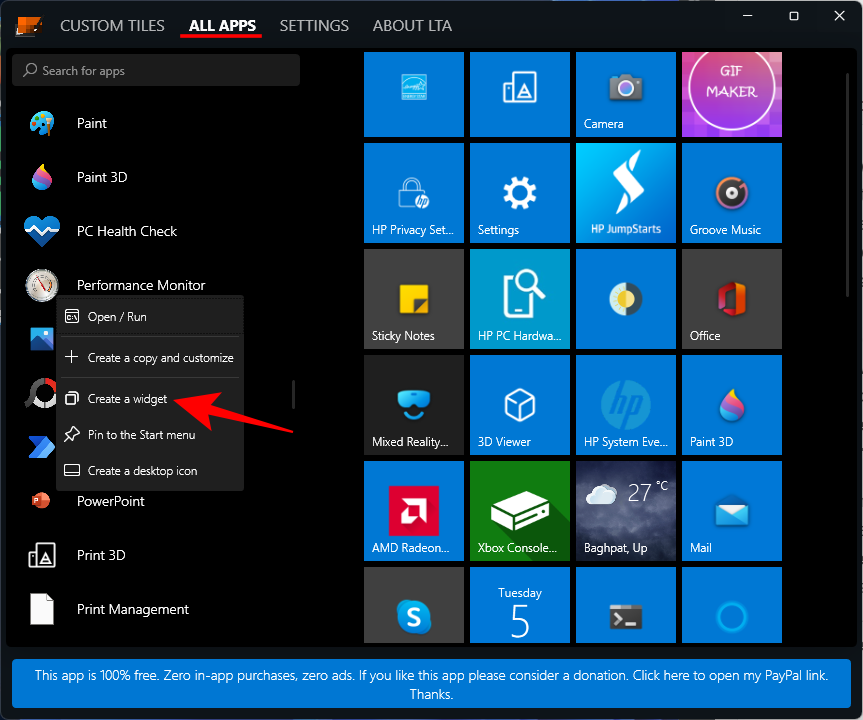
This will directly put the widget on the desktop.
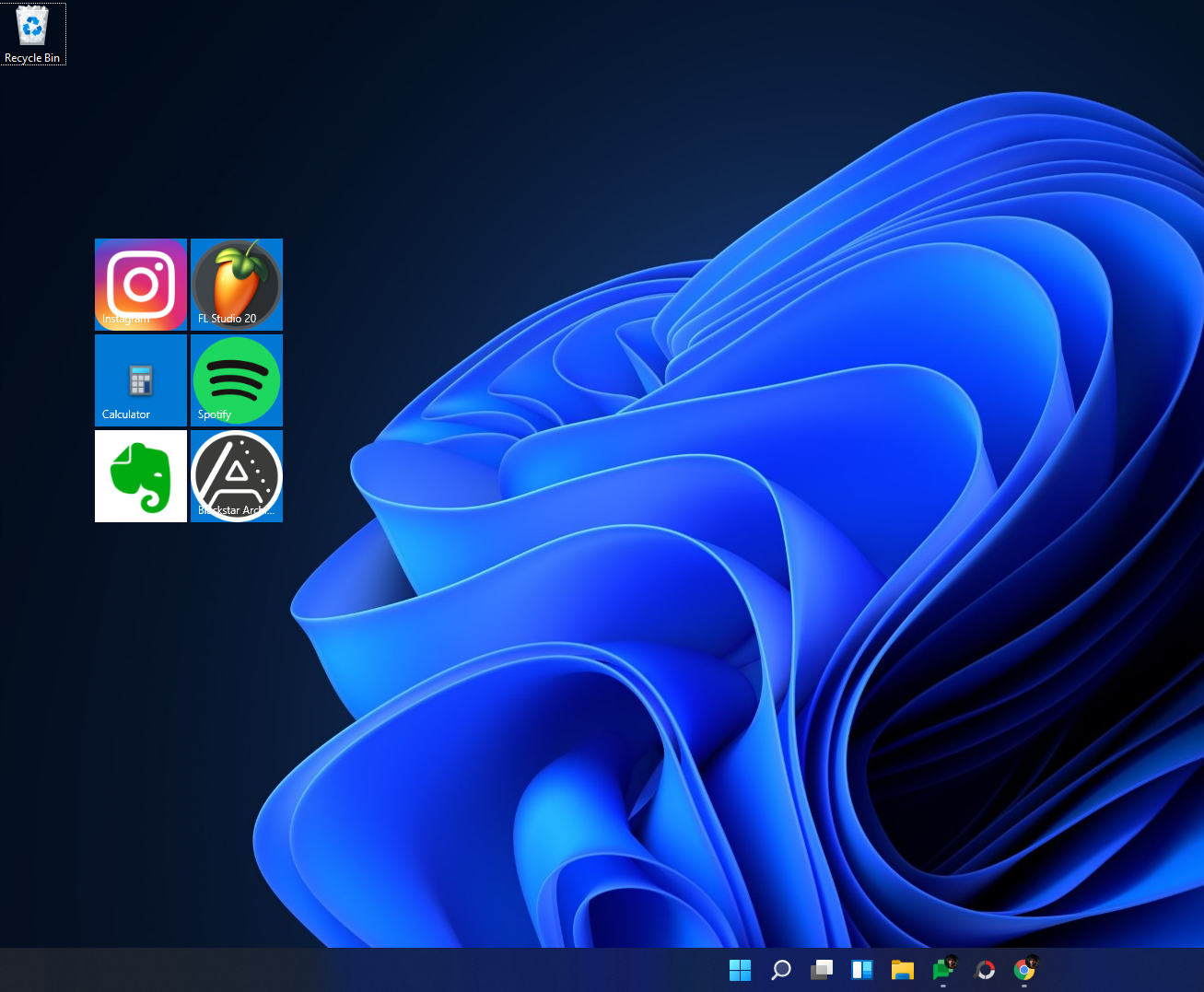
Although not yet perfected, the idea behind the ‘Live Tiles Anywhere’ app has a lot of potential. As the developer makes changes to it, we might see a better version come out soon.
RELATED
- How to Stop the Photos App From Grouping Pictures on Windows 11
- Windows 11 Snap Layouts not working? Here’s how to fix
- How to Set Google Chrome as Default Browser on Windows 11
- How to Change Drive Letter on Windows 11
- How to Make Windows 11 Bootable USB in 4 Easy Steps
- How to Extend Volume Windows 11 or Windows 10
Read Next
Subscribe to Newsletter
Join me on this exciting journey as we explore the boundless world of web design together.
